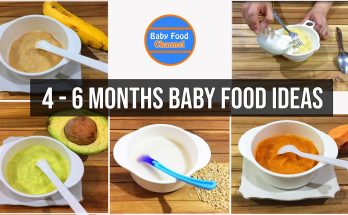Introducing solid foods to a baby can be an exciting but sometimes challenging process for parents. While some babies eagerly accept new flavors, others may be more hesitant. Recent research suggests that a mother’s diet during pregnancy and breastfeeding can significantly influence a baby’s taste preferences. Studies have shown that babies tend to react more favorably to foods their mothers consumed while they were in the womb or during breastfeeding, making early exposure to different flavors an essential part of developing a child’s eating habits.
How Babies Develop Taste Preferences
Babies begin developing their sense of taste long before they take their first bite of solid food. The flavors of the foods a mother eats during pregnancy pass through the amniotic fluid, and later, breast milk, providing the baby with early exposure to different tastes.
The process begins as early as the second trimester of pregnancy when a baby’s taste buds are already forming. The amniotic fluid surrounding the baby absorbs the flavors of the mother’s diet, giving the fetus a taste of what she eats. This means that if a mother frequently consumes foods like carrots, garlic, or vanilla, traces of these flavors can be detected by the baby.
Similarly, during breastfeeding, the flavors of a mother’s diet continue to be passed to the baby through breast milk. Research suggests that this exposure makes babies more likely to accept and enjoy these flavors when they transition to solid foods.
Scientific Evidence on Flavor Exposure in the Womb
A study conducted by researchers at the University of Durham found that babies in the womb respond to different flavors based on what their mothers consume. Using 4D ultrasound scans, the researchers observed how fetuses reacted to various tastes. Pregnant women were asked to consume either carrots or kale capsules, and the fetuses’ facial expressions were monitored. The results showed that babies exposed to carrot flavors displayed more smiles, while those exposed to kale flavors showed more negative reactions, such as frowning.
This study supports the idea that babies can “taste” food before birth and that early exposure to flavors may play a role in shaping their future food preferences.
Breastfeeding and Taste Familiarity
Breastfeeding further reinforces flavor exposure and food acceptance. Unlike formula, which has a consistent taste, breast milk changes flavor based on the mother’s diet. A mother who eats a varied diet exposes her baby to a range of flavors through her milk, increasing the chances that the baby will accept those flavors later when they begin eating solids.
For example, a study published in the journal Pediatrics found that babies who were breastfed by mothers who consumed garlic were more likely to nurse for longer, indicating that they found the flavor appealing. This suggests that babies are naturally drawn to familiar tastes, making it beneficial for mothers to eat a variety of healthy foods while breastfeeding.
How This Affects Weaning and Solid Food Acceptance
The transition to solid foods, also known as weaning, can be easier for babies who have already been exposed to different flavors through their mother’s diet. Babies who have tasted certain flavors in the womb or through breast milk are more likely to accept those same foods when they are introduced as solids.
This can be particularly helpful in reducing picky eating behaviors. If a baby has already been exposed to the taste of vegetables like broccoli or spinach through their mother’s diet, they may be more willing to eat them compared to a baby who is encountering these flavors for the first time.
Additionally, repeated exposure plays a key role in acceptance. Even if a baby initially rejects a certain food, continued exposure increases the likelihood of acceptance over time. Research suggests that it can take 8 to 10 tries before a baby accepts a new food, so persistence is important.
Practical Tips for Parents
Given the evidence that early exposure to flavors can influence a baby’s taste preferences, parents can take several steps to encourage healthy eating habits:
-
Eat a Variety of Healthy Foods During Pregnancy
- Consuming a diverse diet rich in fruits, vegetables, whole grains, and proteins can help expose the baby to different flavors.
- Spices and herbs (in moderate amounts) can also contribute to flavor exposure without causing harm.
-
Continue a Diverse Diet While Breastfeeding
- Mothers who breastfeed should maintain a varied diet to continue exposing their babies to a wide range of tastes.
- If a mother avoids certain healthy foods, her baby may not be familiar with those flavors and could be more resistant to them later.
-
Introduce Solids Gradually and with Familiar Flavors
- When transitioning to solid foods, start with flavors the baby may have already encountered in the womb or through breast milk.
- For example, if a mother ate a lot of carrots during pregnancy, offering carrot puree might be more readily accepted.
-
Be Patient with Food Acceptance
- Babies may initially reject certain foods, but persistence is key. Offering the same food multiple times increases the chance of acceptance.
- Avoid forcing the baby to eat, as this can create negative associations with food.
-
Lead by Example
- Babies learn by observing their parents. If they see their caregivers enjoying healthy foods, they are more likely to develop a positive attitude toward those foods.
Conclusion
Babies are more likely to react positively to foods that their mothers consumed during pregnancy and breastfeeding. The flavors babies experience in the womb and through breast milk shape their taste preferences, making it easier to introduce healthy foods during the weaning stage. By eating a diverse diet and continuing to offer a variety of flavors, parents can help their babies develop a preference for nutritious foods and establish healthy eating habits that last a lifetime.
Understanding this connection between early flavor exposure and food acceptance provides an opportunity for parents to influence their child’s dietary preferences from the very beginning. By making mindful food choices during pregnancy and breastfeeding, parents can set the foundation for a lifetime of healthy eating.



